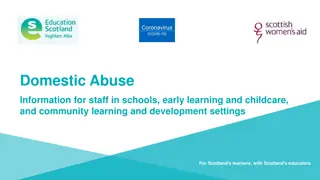Understanding Domestic Violence and Its Impact on Children
This content sheds light on domestic and family violence, acknowledging the impact on children, the importance of recognizing custodial owners of the land, and the prevalence of abuse in society. It defines domestic violence, explores different types including physical, emotional, and financial abuse, addresses pet abuse as a predictor, and delves into coercive and controlling behaviors. The aim is to raise awareness, offer support to survivors, and empower individuals to take a stand against domestic violence.
Download Presentation

Please find below an Image/Link to download the presentation.
The content on the website is provided AS IS for your information and personal use only. It may not be sold, licensed, or shared on other websites without obtaining consent from the author. Download presentation by click this link. If you encounter any issues during the download, it is possible that the publisher has removed the file from their server.
E N D
Presentation Transcript
Domestic and Family Violence and the impact on children. 16 days in WA to Stop Violence Against Women November 2018.
Acknowledgement of Custodial Owners of Land I acknowledge the Whadjuk people of the Noongar Nation as the traditional owners of this land . I recognize their continuous connection to the land, waters and community and pay my respects to elders past, present and future.
Acknowledgement of Lived Experiences. The impact and prevalence of DFV in our society, means it is likely that everyone in the room has been affected by this issue. I would like to take a moment to acknowledge the courage, strength and resilience it has taken for individuals to survive violence and abuse. If you feel at any time you need to leave the room and take some time out please feel free to do so.
What is Domestic Violence ? Intimate partner abuse. Spousal abuse. Behaviour that causes physical, emotional and/or sexual damage, or causes someone in a relationship to live in fear. Non-physical forms of abuse can be just as damaging as physical violence. It is ongoing behaviour that gradually undermines the victims confidence, the severity and frequency of the abuse/violence can escalate over time. Family violence
Types of Domestic Violence Physical Abuse Emotional Abuse Verbal Abuse Sexual Abuse Financial abuse Spiritual and Cultural abuse. Stalking Post separation violence Spousal and Family Homicide
Pet Abuse. Research shows abuse of animals (domestic, farm or wildlife)is a strong predictor for Domestic and Family Violence. 85% of women will delay leaving an abusive partner out of fear for her pets safety. Refuges have recently responded to this issue by installing pet enclosures onsite.
Coercive and controlling behaviour is a purposeful pattern of behavior over months and years. Often the tactics used are not criminal. Isolating a person from their friends and family Control of all aspects of life . (such as where they can go, who they can see, what to wear and when they can sleep). Constant Humiliation. Enforcing trivial demands Inducing physical and emotional exhaustion Enforcing rules and activity which humiliate, degrade or dehumanise the victim Gas lighting is a form of persistent manipulation and brainwashing that causes the victim to doubt herself, and ultimately lose her own sense of perception, identity, and self-worth.
Technological Facilitated abuse. Harassment. Using technology to annoy threaten harass or intimidate. Monitoring/Stalking. Using technology to learn their activities or track their location(drones) Impersonation.(catfishing) Damaging their reputation/relationships. Threats /Punishment. Imaged based abuse (IBA) revenge porn Threatening to harm / humiliate
Rates of violence against women and since the age of 15. 2016 ABS survey 1in 5 Australian women had experienced sexual violence. 1 in 6 Australian women had experienced physical or sexual violence from a current or former partner. 1in 4 Australian women had experienced emotional abuse by a current or former partner. 1 in 3 Australian women had experienced physical violence . 1 in 6 Australian women had experienced an episode of stalking
WA statistics It is conservatively estimated that economic abuse occurs in at least 50 per cent of family violence cases WA Police attended 70,000 Domestic Violence incidents in 2017/18. This is 10,000 more than last year. In 2017-18 in WA 28 domestic homicides Women (13), Men (6), Children and Young People (9). Of the (6) men killed the perpetrators where: A brother (1) son (2), Women Partner (3) *3 additional deaths to still yet be confirmed as DV Homicides 20% of women experiencing domestic violence report to the police. The most dangerous time for women and children is the period immediately after leaving. This is when the risk of homicide is at its greatest. In WA 40%of Women's and children's homelessness is caused by Domestic and Family Violence . Indigenous women are 31 times more likely to be hospitalised due to family violence than other women.
Abuse of children and young people Experiencing DFV and Witnessing DFV Exposed to Domestic and Family Violence. The impact depends on: Age, gender, length of exposure, Severity of violence, Resilience factors. Research has also indicated that children s ability to cope with the adversity of living in a violent home is linked to their mothers ability to maintain mothering functions, to model assertive and non-violent responses to abuse and to maintain positive mental health
Abuse of children and young people Exposure to DFV is recognised as a form of child abuse. The Department of Communities Child Protection and Family Support division assumes that DFV will be present in all concern for child cases it investigates. In 2016 there were 5.7 million children in Australia, best estimates are that 8% of boys and 20% of girls are sexually abused ( 90-95%of abuse is by men). Young women in dating relationships 15-19 years experience sexual violence at four times the rate of any other group.
Impacts of Domestic and Family Violence on Children. Approximately 20% of women experience Domestic Violence for the first time while they are pregnant. Children exposed to Domestic Violence can be impacted neurologically before birth. A Mothers high levels of anxiety, stress and trauma will affect the development of the fetus.
Living with a parent who uses violence and abuse. inconsistency and living in the NOW, rules and routines are at the whim of the abuser. physical restrictions and unrealistic parental expectations children cannot anticipate the behaviors of others. they learn not to express a preference until the abusive parents mood is ascertained . Children learn to mute their feelings and behavior .
Effects on a childs development An important cognitive development is the establishment of cause and effect relationships, they may not develop a sense of control in their own lives. For these children there can be a lack of motivation, and a lack of a personal sense of achievement and responsibility for their behavior. A major area of cognitive development that is impacted when living in violence is a sense of self, of being a person who can make choices and express their preferences.
What Children Learn from abusive and controlling fathering. Children learn that it's acceptable to use violence to deal with disagreements, and that it's okay to hit someone if they don't agree with what that person is saying or doing. Children learn that hitting is a good way to make someone stop doing something they don't like, or to make someone do something s/he doesn't want to do. Children learn that others have the control - especially bigger stronger others. They do not learn that they can make decisions themselves, that they are capable of doing so. Children learn that love and violence go together. This sets the stage to accept violence in other relationships.
Children learn that when someone is under stress, tense or angry, violence is an acceptable way to cope. Children learn that they deserve to be hit if they have done something that the other person disapproves of. Children learn to deal with other authority figures, like teachers, in unhealthy ways. Children learn not to get caught. Children learn to avoid the person who has abused them, and they lose trust in that person. They learn that this person is not safe and cannot be relied upon to help
Domestic Violence and Parenting Perpetrators: are more often controlling and authoritarian, less consistent and more likely to manipulate the children and undermine the mother s parenting. Perpetrators often outwardly appear to be good parents e.g., during assessments or in public. This is part of the power and control dynamic. Victim: in the face of severe stress many abused women compensate for violent events by offering increased nurturing and protection to their children. Some women, during times of violence, are outwardly aggressive towards their children. This is often to try and prevent the pertetrator s violence .
Separation and Contact Visits Very rarely does violence end after separation up to 90% of women continue to experience harassment and abuse after the relationship has finished. Separated Fathers may deliberately use the child to spy on the mother, continually denigrate and criticise the mother, deliberately undermine and sabotage the mothers parenting practices, bribe the child, and fail to show any parental responsibility for the child when on a contact visit .
Intergenerational nature of abuse. Research findings in this field have been mixed and that most children growing up with violence will become adults who are neither perpetrators nor victims of violence (Elizabeth 2005: 2; see also Tomison 2000). children from violent homes display diverse attitudinal and behavioural responses to violence against women. A study by VicHealth found that adults who had been exposed to violence as children could be classified into two attitudinal categories those who were significantly more tolerant than average of relationship violence and those who were significantly less tolerant than average of relationship violence.
Reasons why children dont tend to disclose Fear of retribution if the abuser has threatened them Shame and humiliation Belief that they caused the abuse Belief that no-one can help That you will tell the father what he/she has said That the child will be taken away from the family
However... Children are not passive in their experience of violence, they actively resist,respond and cope with violence, sometimes at levels well beyond their years And, most importantly, Studies have shown that children are able to recover, or work towards recovering from trauma once in a safer, more stable environment.























